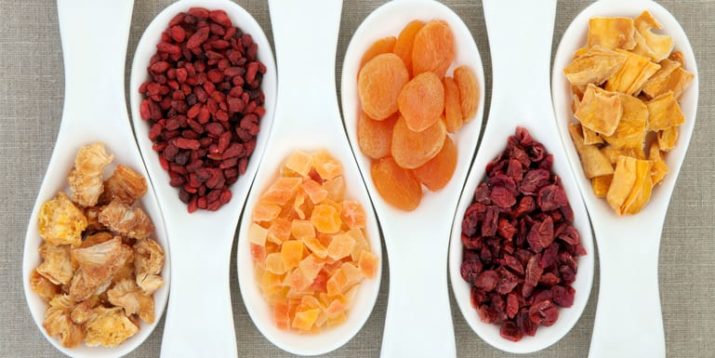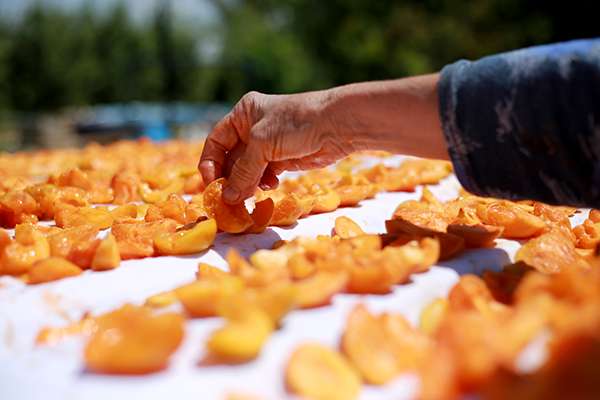Is Dried Fruit Really All That Healthy for You?

You feel virtuous (and maybe a little smug) when you opt for a bag of dried fruit over the tempting array of candy bars and potato chips at the gas station. But is your snack of choice actually a smarter, more nutritious snack? Is dried fruit healthy?
Generally speaking, dried fruit is healthy — especially compared with most packaged, processed treats. But, not all dried fruit is desiccated equal. Here’s what you need to know to make the healthiest dried fruit choices.
What Is Dried Fruit?

Dried fruit is fruit that’s been dried using various methods to remove the water, preserve the fruit, and concentrate its flavor.
Commercial practices include: sun drying, atmospheric drying (using a kiln or other apparatus to continually pass heated air over the fruit), and vacuum dehydration (using low air pressure to remove moisture).
Some fruit is first treated with a preservative (sulfur dioxide, typically) to lengthen shelf life and prevent oxidation.
“Sulfur protects these fruits from browning and the loss of vitamins A and C,” says Danielle Gaffen, MS, RDN. “Unfortunately, the sulfur also destroys vitamin B1 [thiamin] and may also cause headaches or allergic reactions in individuals with sulfite sensitivities.”
If you want to avoid certain food preservatives and added sugars, you can make your own healthy dried fruit snacks at home using a tabletop dehydrator, which circulates warm air around trays of sliced fruit, or an oven set at a low temperature.
3 Benefits of Dried Fruit
“Overall, I think dried fruit is pretty great,” Gaffen says. Like fresh fruit, dried fruit offers a variety of nutritional benefits, she adds.
1. Nutrients
“Dried fruit has fiber, vitamins, minerals, and antioxidants.”
2. Convenience
Dried fruit is lighter and more compact than fresh fruit, won’t bruise, and doesn’t require refrigeration. That’s one reason why it’s such a common road trip and hiking snack.
3. Spoilage resistance
“Drying fruit removes its water,” Gaffen says. “The bacteria that cause food to spoil need water to live. With less water in a fruit, fewer bacteria can grow.”
Dried Fruit’s Downside

While dried fruit is healthy, it does have more sugar content than fresh fruit. There are a couple of reasons for this, says Melissa Macher, RD, LD.
“Dried fruit has lost its water and thus has become more concentrated,” she says. “And sometimes food companies will add sugar to their dried fruit products for taste and as a preservative.”
That makes dried fruit much easier to overeat than fresh fruit. Gaffen illustrates:
“Would you eat 10 fresh apricots?” she asks. Unlikely, right?
“But how easy would it be to eat 10 dried apricots? Less water in dried fruit means it takes up less room in our stomachs. Since one factor that regulates our hunger signals is volume, it’s likely we’ll eat more dried fruit than fresh fruit to feel as full.”
And that can mean consuming more sugar than is contained in the processed snack foods we often eat dried fruit to avoid.
For instance, a serving of dried, unsweetened mango contains 130 calories and 29 grams of sugar. Compare that with a Twinkie‘s 140 calories and 16 grams of sugar per cake (remember that there are two per package!).
That said, the dried mango contains 3 grams of fiber, phytonutrients, and vitamins C and A; the Twinkies contain negligible amounts of nutrients, save for 20 mg of calcium.
So moderation when consuming dried fruit is key. This is why it’s important to review nutrition labels, both for added sugar and recommended serving size.
Dried Fruit vs. Fresh Fruit: 5 Things to Know
1. Dried fruit can be sweeter than candy
Drying concentrates natural sugars within fruit, and sometimes sweeteners are mixed in during this process. When this happens, you could stumble into Candy Land without realizing it.
In sugar content, sweetened dried mango (83 percent of calories from sugar) surpasses licorice sticks (60 percent of calories from sugar) which eclipse milk chocolate (39 percent of calories from sugar). To cut down on added sugar, go for unsweetened varieties of dried fruit.
2. Dried fruit triggers fructose fears
High fructose corn syrup (HFCS), a common sweetener made from corn starch, has been widely controversial for years. HFCS, and fructose (a.k.a. fruit sugar) by association, are blamed for the obesity epidemic in the U.S. and globally (note: Clinical trials have yet to identify fructose as a cause of obesity).
Fructose is found naturally in fruit and honey. Its presence may make some approach dried fruit with caution. But, don’t get swept up in the fear of fructose. It’s a sugar and, like all sugar, should be enjoyed in moderation… which brings us to the next point.
3. Portion distortion is easy with dried fruit
Drying fruit removes moisture and reduces the fruit’s volume. According to the American Heart Association, a typical serving of fruit is 1/2 cup of fresh fruit or 1/4 cup of dried fruit.
In other words, don’t mindlessly snack on dried fruit — portion it out in advance. BODi recommends subbing 1 yellow Portion Fix container for 1/4 cup of dried fruit no more than three times a week.
4. Dried fruit can contain sulfites
Sulfites and their chemical cousins (think: potassium sulfite, sulfur dioxide, etc.) are often used as preservatives in dried fruits. Sulfites can trigger allergic reactions, so if you or someone you love has an allergy or sensitivity to sulfites, always check the ingredient list on dried fruits.
5. Not all drying methods are equal
Processing fresh fruit into dried fruit usually results in the loss of heat-sensitive vitamins and minerals. These heat-sensitive nutrients include vitamins A and C, and thiamin. Virtually all fruit-drying methods use heat except for freeze drying, regarded as the best method for removing water while preserving nutrient content.
What’s the Best Dried Fruit to Eat?
Just like there’s no absolute healthiest fruit, there’s no best dried fruit option. The healthiest approach is to eat a variety of dried fruits while paying attention to portion size and natural sugar content. Some dried fruits are higher in calories than others.
When choosing packaged dried fruit, it’s best to opt for varieties that don’t have added oils and aren’t sweetened with added sugar. (Sour or tart fruits, like cranberries and cherries, often contain added sugar to make them more palatable.) And if you have any sensitivity to sulfites, steer clear of brands that use sulfur dioxide as a preservative.
